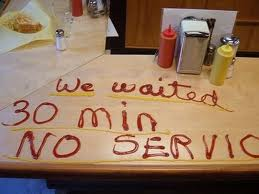What happened to our Brand? It dropped through the gap between Customer Service and Customer Experience…
Which has the bigger impact on the bottom-line: ticking the boxes for slick customer service or having customers feel and behave as you intended?
There’s nothing new in saying Customer Service isn’t the same as Customer Experience but I’m often asked if it matters that much. It should matter, very much. Fortunately (or rather, unfortunately) there’s no shortage of examples that show why.
Imagine if you will, a high-level meeting within a lar ge passenger rail franchise discussing latest performance figures. “How were our customers last month?” someone asks, eventually.
ge passenger rail franchise discussing latest performance figures. “How were our customers last month?” someone asks, eventually.
“Well, it’s all looking ok” comes the response. “100% of the trains left and arrived on time and every train was fully staffed to help our guests. Passenger numbers were up, especially on the peak-time trains and yet we coped with no additional costs of extra capacity. Customer satisfaction was down a few notches at 20% but that’s probably just a statistical anomaly in the calculation again”. And so on. The meeting closes with no further action points, happy that everything is, pardon the pun, on track.
The service picture (the bits they are looking at) is shaping up well but there are always two sides to every story. So in that same month, what did it really look and feel like to be a passenger. One passenger (yours truly) had the same experience on many occasions…
I leave the jostling of a rush-hour underground system behind and step into the main-line terminal concourse. Phew. It’s been a long day, I’m tired, I left home well before dawn and now because my meeting overran, I’ll miss putting the kids to bed. Not much I can do now though. I had a seat reserved but it was on the train that left a while ago. Still there’s one every hour and I’ve got a flexible ticket so I’ll go grab a coffee and get the next one.
Hang on. Coffee will have to wait. It’d be nice to wind down this time in the evening but I’ve a gauntlet to run. Like anticipating the lights of a grand prix start, I – and it seems several hundred others – are taking up a position of stealth. We need to be at just the right place where we can see the platform number ‘revealed’ so that when the swarm of flailing jackets, cartwheeling suitcases and over-size man-bags makes a bolt for it, we’re right at the front. The prize? A seat. It’s a very basic expectation, it’s not much to ask, but it’s not guaranteed.
The platform’s called and suddenly it’s like the whole All Blacks squad is chasing down a loose ball. Work shoes are not meant to be run in. It’s frantic and all very undignified. Once on board, pause to put a bag in the rack overhead and you’ll find someone’s jumped into your seat and then, conveniently, they grow selective hearing and the manners of a potato.
The result? I paid a premium price to travel at peak time and to have a degree of flexibility. Yet I (and many others) have to stand in a draughty, noisy doorway near a toilet for the first hour or so of a two-hour journey. This often happens but we all agree they don’t respond to complaints and so our collective plans to use a different route and franchise next time quickly take shape.
I won’t go on. Back to the meeting then. The point is that ticking the boxes of customer service is fine to an extent as long as they are the right boxes. Nonetheless, the brand and P&L will be seriously undermined if that’s not done in the context of knowing – in a timely manner and being prepared to do something about it – how what happens makes customers feel and behave; how that writes the story they will tell about their brand experience.
As they say, whatever the intention, whatever the strapline offers, the brand is what the brand does.
Jerry Angrave Customer Experience Consultant +44 (0) 7917 718 072 www.customerexperience.uk.com [email protected] Jerry Angrave helps business leaders plan and deliver Customer Strategies, design and execute customer experience programmes and provides coaching and personal development tools for those charged with leading and managing the customer agenda. These services are borne out of real-world know-how in running teams of Customer Experience professionals and Customer “champions” in large complex businesses. Twitter – @IdealExperience LinkedIn – http://uk.linkedin.com/in/improvecustomerexperiences






